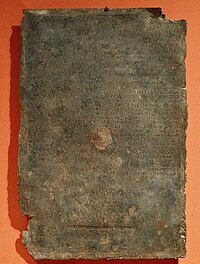| Tabula Banasitana | |
|---|---|
 | |
| Material | Bronze |
| Created | Second century AD |
| Place | Banasa |
| Present location | Rabat |
Tabula Banasitana is an inscribed bronze tablet produced in the second century AD. Found in 1957 near the village of Banasa in Morocco, it documents how a notable of the Berber tribe of Zegrenses successfully petitioned to receive Roman citizenship for him and his family. Fergus Millar has noted its importance as "perhaps our finest documentary item of evidence for the archival procedures of the Roman emperors and for the limits and consequences of granting citizenship, as well as affording some glimpses of social structure in a marginal area of the empire." The text was published for the first time in 1971. The tablet is currently at the Museum of History and Civilizations in Rabat.
The Latin text on the tablet consists of three parts: a grant from the emperors Marcus Aurelius and Lucius Verus to the Zegrensis Julianus, his wife Ziddina and their four sons in 168/169; a second grant from Marcus Aurelius and Commodus to Faggura, the wife of Aurelius Julianus, the princeps of the Zegrenses, probably the son of the earlier Julianus, and their children in 177; and an authenticated copy of the entry from the central register with the names of twelve senior figures, senators and equestrians.
References
- MacKendrick 2000, p. 295.
- Eck 2007, p. 270.
- Millar 1983, p. 105.
- Seston & Euzennat 1971.
- MacKendrick 2000, p. 300.
- Seston & Euzennat 1971, pp. 473, 478.
- Rhorfi 2002, p. 560.
- Seston & Euzennat 1971, pp. 473, 480, 482–483.
- Eck 2007, p. 198.
- Whittaker 2007, p. 524.
Bibliography
- Eck, Werner (2007) . Bowman, Alan K.; Garnsey, Peter; Rathbone, Dominic (eds.). The Cambridge Ancient History. Cambridge University Press. ISBN 978-0-521-26335-1.
- MacKendrick, Paul Lachlan (2000). The North African Stones Speak. UNC Press Books. ISBN 978-0-8078-4942-2.
- Millar, Fergus (1983). "Epigraphy". In Crawford, Michael (ed.). Sources for Ancient History. Cambridge University Press. ISBN 978-0-521-28958-0.
- Rhorfi, Abdellatif (2002). "La Pax romana en Tingitane et les conditions de sa permanence aux trois premiers siècles ap. J.-C". L'Africa Romana (XV). Rome: 560.
- Seston, William; Euzennat, Maurice (1971). "Un dossier de la chancellerie romaine : La Tabula Banasitana. Étude de diplomatique". Comptes rendus des séances de l'Académie des Inscriptions et Belles-Lettres. 115 (3): 468–490. doi:10.3406/crai.1971.12653.
- Whittaker, C. R. (2007) . Bowman, Alan K.; Garnsey, Peter; Rathbone, Dominic (eds.). The Cambridge Ancient History. Cambridge University Press. ISBN 978-0-521-26335-1.